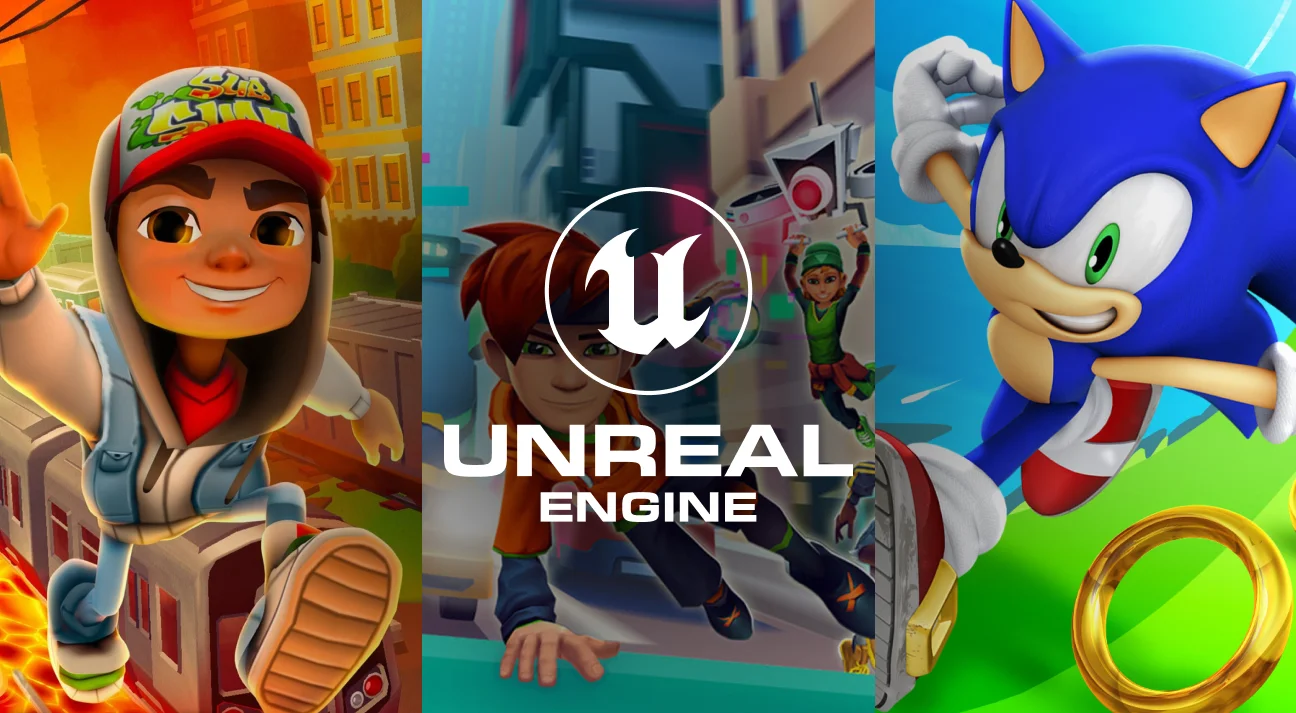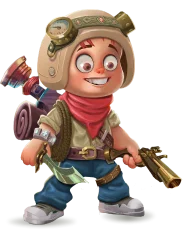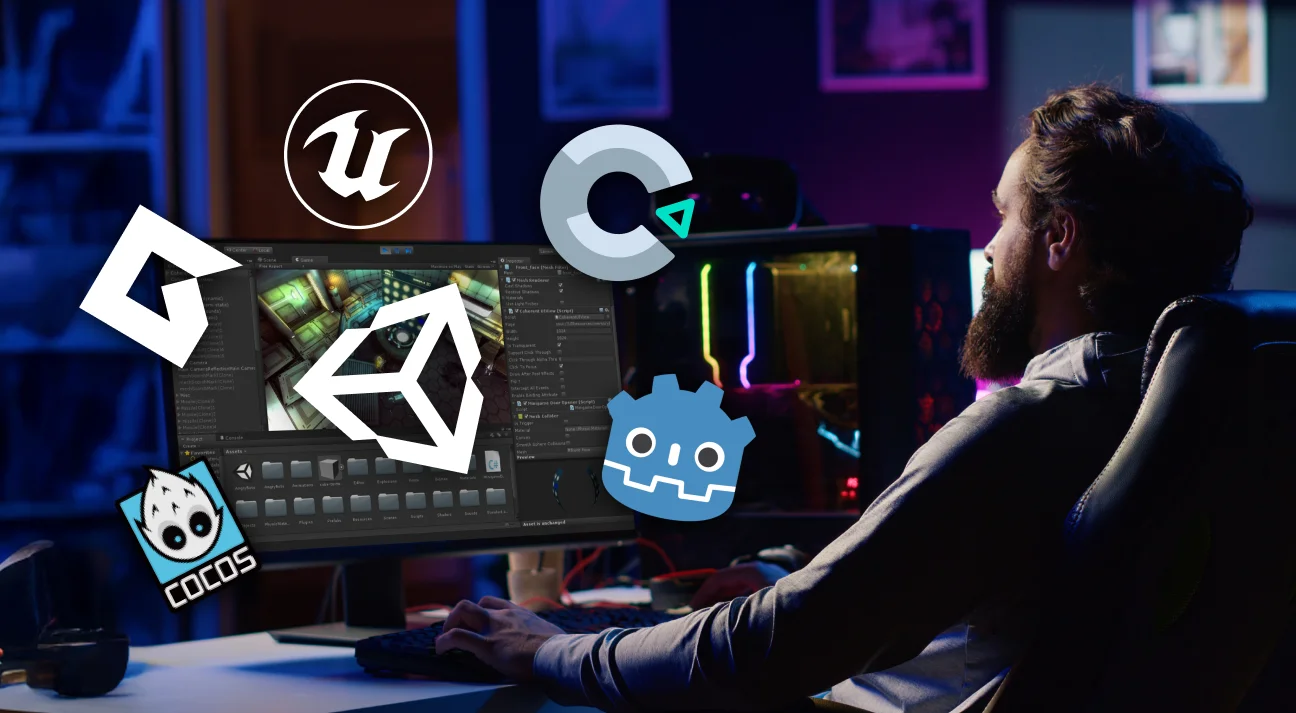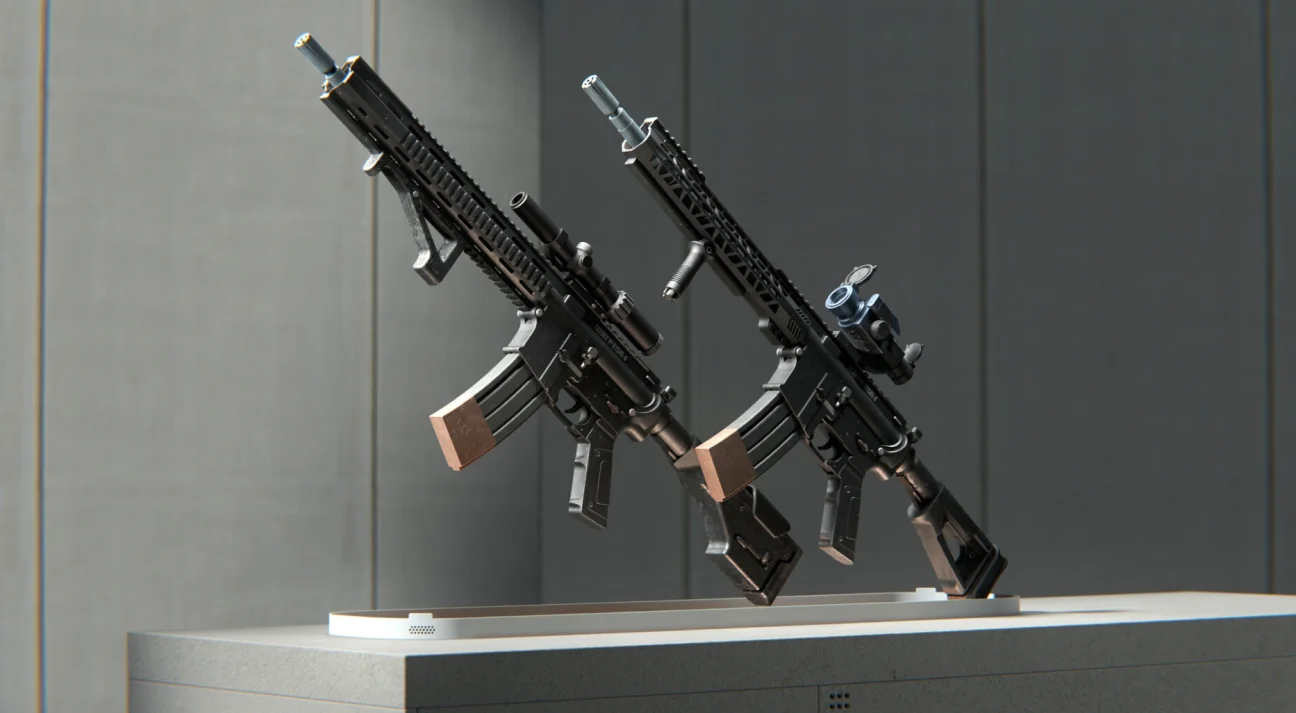
How to Make an Endless Runner Game in Unreal Engine?
Endless runner games are popular amongst gamers worldwide, and Unreal Engine is a preferred choice for building such games. Around 60% of game developers use game engines for game development, and Unreal Engine has 14.85% of that market share. When it comes to building Endless Runner games, Unreal’s competencies attract developers to employ it to build captivating games. So, do you want to leverage Unreal Engine for Endless Runner development? If yes, let this blog get you there!
From Tron RUN/r to Supermoves and Bullets Per Minute to Ghostrunner, Endless Runner game is a popular genre in the game development arena. Backed by Unreal Engine’s exceptional competencies, these games are well-known for their engaging game mechanics, replayability, and immersive gaming experience.
These games challenge gamers to keep moving forward endlessly while avoiding obstacles, collecting power-ups, and accumulating high scores. Attributed to these features and playabilities, they deliver exceptional gaming experiences, and the credit goes to Unreal Engine, which allows these games to stand out from the crowd.

This blog is going to let you know how to develop an endless runner game in Unreal Engine. Right from laying the foundation of core game mechanics to creating dynamic environments, implementing player characters, and the like, it covers everything you need to bring your game ideas to life.
Endless Runner Games in Unreal Engine
An Endless Runner is a game type that features a perpetually moving character continuously moving forward through a procedurally generated environment, circumventing obstacles and accumulating rewards. The very game type typically doesn’t have a set endpoint, allowing players to survive as long as they can while achieving high scores. Temple Run, Subway Surfers, and Jetpack Joyride are among the best examples of top-notch Endless Runner games.
Key Features of an Endless Runner Game in Unreal Engine
Backed by its high-end graphics, blueprints system (virtual scripting), and robust physics engine, Unreal Engine is a powerful tool for endless runner game development. It allows developers to create stunning game environments, smooth character movement, and dynamic level generation. Here’s how Unreal Engine game development is revolutionizing the gaming:
The following are the compelling features of the Endless Runner game built using Unreal Engine:
- Procedural Level Generation: It allows dynamic game world creation, ensuring an unpredictable experience.
- Character Movement & Animation: In general, players run, jump, slide, or dodge obstacles.
- Obstacle & Power-Up Systems: Hazards and collectibles are placed randomly, keeping gameplay engaging.
- Increasing Difficulty: It enables the game to speed up and add more obstacles as time progresses.
- Scoring System: Helps keep track of player progress, rewarding skillful play.
How to Develop an Endless Runner Game in Unreal Engine
Here are the key steps to develop an endless runner game in Unreal Engine:

Laying the Foundation of Game’s Mechanics
Establishing the foundation for game mechanics should be the priority, as it sets the stage for the entire game development. It involves determining the core gameplay loop, including the player’s character, which will run automatically, and the preliminary interaction, which involves jumping, sliding, or shifting sideways to circumvent obstacles.
Fast-paced action and continuous gameplay are the key aspects that endless runner games captivate players with. Game developers make use of Unreal Engine’s Blueprint visual scripting system and C++ to create high-performance game mechanics. The process involves implementing obstacle interaction, character movement, and progressive difficulty scaling, ensuring an engaging, immersive, and seamless gaming experience.
Example: “Tron RUN/r”
“Tron RUN/r” is one of the examples of Endless Runner games developed with Unreal Engine 4. Here’s how the very game used Unreal Engine to be highly interactive and immersive:
- Employed Blueprints and created smooth and highly responsive character controls.
- Leveraged Unreal’s physics engine, ensuring smart handling of fast-paced dodging and obstacle interactions.
- Implemented real-time lighting and reflections and fitted the neon aesthetic of the Tron universe.
- Helped in performance optimizations to ensure smooth gameplay at high speeds.
Constructing the Game Universe
Constructing a visually stunning and immersive game universe requires a detailed setting and background design that captivates players. The process begins by ascertaining the theme, whether it’s urban, futuristic, or fantastical, and then letting it navigate the narrative and visual elements.
Game developers leverage Unreal Engine’s robust rendering engine, including features such as Nanite for detailed environment creation and Lumen for dynamic lighting. They use Quixel Megascans and custom 3D assets, allowing them to create a visually appealing and highly engaging game universe.
Unreal Engine allows them to create immersive landscapes that evolve as the player progresses. Game developers can implement various atmospheric effects, such as weather changes and lighting, to enrich the game environment.
Example: “Supermoves”
Utilizing Unreal Engine 5, “Supermoves” creates a vibrant parkour-based universe, enabling players to perform different moves, including flipping and wall running in diverse environments. Here’s how Supermoves leveraged Unreal Engine’s competencies to stand out:
- Leveraged Lumen Global Illumination to create dynamic lighting capable of reacting realistically to movement.
- Utilized Nanite Virtualized Geometry, ensuring highly detailed cityscapes without affecting performance.
- Employed procedural tools to create varied environments that feel fresh every run.
- Ensured seamless integration of physics-based interactions like wall-running and flipping.
Creating the Game Environment
Creating a well-crafted game environment requires enriched game art and experience. Game developers, in this phase, develop detailed environments, ensuring the game delivers an interactive and immersive gameplay experience. Using Unreal Engine’s Level Designer and procedural generation techniques, game developers create varied and dynamic environment settings. Exploring a list of best 2D game engines can also be helpful for teams focusing on simpler or sprite-based projects before scaling to 3D.
Furthermore, leveraging landscape tools and material shaders ensures high-performance, optimized levels capable of running smoothly across platforms.
Example: “Ghostrunner”
Ghostrunner, integrating fast-paced action with a compelling narrative, enhances the overall gameplay experience, showcasing Unreal Engine’s versatility. Here’s how the game used the power of Unreal Engine:
- Used PBR (Physically-Based Rendering) for realistic metallic surfaces in a cyberpunk world.
- Integrated real-time reflections and ray tracing to enhance immersion.
- Leveraged highly detailed 3D assets like efficient LOD (Level of Detail) management without performance loss.
- Ensured seamless transitions between levels using streaming technologies.
Implementing the Player Character
Implementing the player character in an Endless Runner game includes designing animations, physics, and controls. It ensures seamless transitions between actions, such as running, jumping, sliding, and dodging obstacles. Game developers configure intuitive controls and mechanics to create a responsive and enjoyable player experience.
Leveraging the competencies of Unreal Engine’s Character Movement Component, they enable smooth running, jumping, sliding, and dodging mechanics. In terms of mobile games, game experts tend to implement touch controls and gestures, fostering a seamless experience across devices.
Example: “BPM: Bullets Per Minute”
It’s a roguelike rhythmic first-person shooter game developed by Awe Interactive. This game integrates a Valkyrie character and has its actions synchronized to a rhythm, showcasing Unreal Engine’s competencies to handle complex character mechanics. Here’s how the game made use of Unreal Engine:
- Employed inverse kinematics (IK) and animation blending for fluid character movements.
- Ensured easy implementation of character customization and power-ups.
- Allowed motion-captured animations to make character movement way more realistic.
- Offered Blueprint scripting, minimizing coding complexity while tweaking mechanics.
Character Models and Animations
Character models and animations are crucial in Endless Runner game. Unreal Engine enables developers to create detailed models that reflect game’s theme and dynamic animations to communicate swift movements and interactions. Game developers employ Unreal Engine’s MetaHuman Creator to create high-end character models.
Developers use Unreal Engine’s Animation Blueprint system and State Machines to create smooth, responsive transitions between movements like jumping, running, and dodging. These animations are tightly synced with gameplay mechanics, ensuring visually appealing characters move fluidly and feel intuitive to control.
Example: “Unbound: Worlds Apart”
Built using Unreal Engine, the game features detailed character models and fluid animations, contributing immensely to its engaging gameplay. Here’s how this game used Unreal Engine to become highly engaging and interactive:
- Employed high-quality shaders, creating detailed textures for character designs.
- Leveraged Cascade and Niagara VFX for character effects, including magic portals.
- Ensured real-time animation previews, accelerating the workflow.
- Provided blend spaces for seamless animation transitions, such as running, jumping, and stopping.
Generating an Infinite Level
In an endless runner game, generating an infinite level involves the game’s procedural generation, accelerated level streaming, and randomized obstacles to ensure frequent, unpredictable, and engaging gameplay with no repetition. This phase includes implementing procedural level generation using C++ and Blueprints, ensuring an endless flow of engaging and dynamic gameplay.
Game developers ensure they implement a system that dynamically spawns and removes level tiles as per the player’s progress. They do so by leveraging Object Pooling techniques, optimizing performance, and circumventing memory leaks.
Example: “Phantom Abyss”
Developed by Team WIBY and published by Devolver Digital Phantom, Abyss is an action-adventure video game. In this game, players attempt to escape trap-filled temples, making use of a whip, like in the Indiana Jones franchise. Here’s how the very game leveraged Unreal Engine to stand out of the crowd:
- Used Unreal Engine’s Blueprints and procedural level generation systems to dynamically create unique temples in every run, ascertaining that no two playthroughs are the same.
- Leveraged Unreal Engine’s physics engine that allows dynamically placed traps, moving platforms, and destructible environments, ensuring each run remains unpredictable, challenging, and engaging.
- Made use of Unreal’s async level streaming that loads new sections in real-time without loading screens, enabling seamless, procedurally extended levels.
Enhancing the Gameplay Experience
Enhancing an endless runner’s gameplay experience involves refining controls, visuals, AI behavior, and introducing dynamic challenges. Developers often implement progressive difficulty through time-based speed scaling, ensuring the gameplay remains fluid, engaging, and increasingly challenging.
Furthermore, Unreal Engine’s Sound Cue System allows them to implement sound effects & immersive background music to enhance the player’s auditory experience. With Unreal Motion Graphics (UMG), game developers create a user-friendly interface with dynamic game menus, score counters, and health bars, elevating the overall game experience.
Example: “Ghostrunner”
Ghostrunner, integrating fast-paced action with a compelling narrative, enhances the overall gameplay experience, showcasing Unreal Engine’s versatility. Here’s how the game used the power of Unreal Engine:
- Used Unreal’s Character Movement Component and implemented parkour mechanics.
- Employed time dilation effects, creating slow-motion moments.
- Elevated gameplay experience with adaptive music and real-time post-processing effects.
- Ensured smooth wall-running mechanics, a feature that makes the game stand out.
Testing and Optimizing the Game
To ensure fluid, bug-free gameplay in endless runner games, developers leverage Unreal Engine’s powerful suite of automated testing, real-time debugging, and profiling tools. These capabilities help deliver consistent frame rates and smooth performance across devices.
Using Unreal, they can conduct thorough playtesting and debugging, ensuring a polished gaming experience. The optimization techniques include:
- CPU and GPU profiling to optimize rendering efficiency.
- Level of Detail (LOD) models for performance enhancement.
- AI testing and simulation tools to assess player movement and behavior.
Example: “BPM: Bullets Per Minute”
BPM conducted rigorous testing and optimization to synchronize gameplay with musical beats, demonstrating Unreal Engine’s testing capabilities. Here’s how the very game made use of Unreal Engine to stand out:
- Employed profiling tools (GPU and CPU Profiler, Stat Commands) to optimize the game.
- Optimized audio synchronization with gameplay, essential for rhythm-based mechanics.
- Provided automatic LODs for performance scaling, enabling the game to run well on high-end as well as low-end devices.
- Integrated extensive debugging tools to make performance tuning way more convenient.
Packaging and Publishing Your Game
Last but not least, packaging and publishing an Endless Runner game includes optimizing assets, ensuring cross-platform compatibility, and ensuring a seamless distribution of the game on platforms like PC, mobile, and consoles. Game developers using Unreal Engine’s deployment tools ensure seamless game publishing.
Developers make use of Unreal Engine’s Packaging Tools and compile the game efficiently. These tools help them publish the game on different platforms like Play Store, App Store, and Steam.
Example: “Unbound: Worlds Apart”
This is one of the examples of a game that has experienced successful packaging and publishing using Unreal Engine’s capabilities. It exemplifies Unreal Engine’s support for cross-platform deployment. Here’s how it used Unreal Engine to come into existence:
- Utilized Unreal’s packaging tools, creating optimized game builds.
- Leveraged multi-platform deployment including mobile, PC, and console with minimal changes.
- Ensured convenient localization and UI adaptation for various markets.
That’s all there’s to the steps of building Endless Runner games in Unreal Engine! From laying the foundation to constructing the game universe, implementing characters, enhancing gameplay experience, testing & customization, and deployment, this blog explains each step involved in the very process. Now that you’ve come to know it, consider implementing it and bringing your game idea to life!

From Idea to Interactive Gameplay Experience – 300Mind Helps You Get There!
Attributed to their simple, addictive gameplay and convenient access, endless runner games have maintained their popularity, making them appealing to game lovers. However, endless runner game development requires expertise in creating game mechanics, level design, and optimization, needing you hire dexterous game developers.
300Mind is a leading game development company, embellished with a wide range of vetted developers excelling at game development. Specializing in Unreal Engine game development services, our highly skilled developers deliver high-quality, engaging, and market-ready games that align with your business needs.
Leveraging our expertise, we’ve built numerous games, separating us apart from the rest. Some of our creative works involve Bal Hanuman and Dots & Boxes that have expanded user’s expectations. So, if you’ve an Endless Runner game idea, get in touch with us and leverage our expertise to turn it into reality with ease!
FAQs on Endless Runner game Ideas
Backed by its many exceptional offerings, Unreal Engine is the right choice for endless runner game development. It provides powerful tools and visual scripting competencies with Blueprints and allows the creation of dynamic and engaging games, which involve tile-based level design and detailed character animations.
An Endless Runner is a dynamic video game genre that tends to challenge players to control a character that is perpetually moving forward through a constantly evolving environment. It requires quick reflexes and strategic maneuvering to efficiently circumvent and gather rewards.
Endless runner games introduces new challenges, power-ups, and in-game events, keeeping the gameplay experience fresh and engaging. They might also feature a wide range of environments and character customization options to keep player interest maintained over time.








